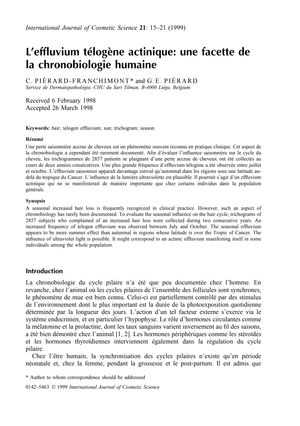L’effluvium télogène actinique: une facette de la chronobiologie humaine
February 1999
in “International Journal of Cosmetic Science”

TLDR Hair loss increases between July and October, possibly due to UV light, and factors like skin type, hair color, and density may affect this. Dandruff can worsen hair loss conditions.
In the 1999 study by C. Piérard-Franchimont and G. E. Piérard, involving 2857 patients, researchers found a seasonal pattern in hair loss, with an increased frequency of telogen effluvium, particularly between July and October, suggesting that ultraviolet light may contribute to this seasonal hair loss, termed actinic effluvium. The study highlighted that while many individuals perceive abnormal hair loss, over half of these cases were found to have normal hair cycle patterns upon objective evaluation with trichograms. The findings also suggest that factors like phototype, hair color, and hair density may influence susceptibility to actinic effluvium, which could potentially exacerbate androgenetic alopecia. Moreover, the presence of dandruff or seborrheic dermatitis may worsen the prognosis of androgenetic alopecia due to associated infraclinical to moderate inflammation.
View this study on onlinelibrary.wiley.com →